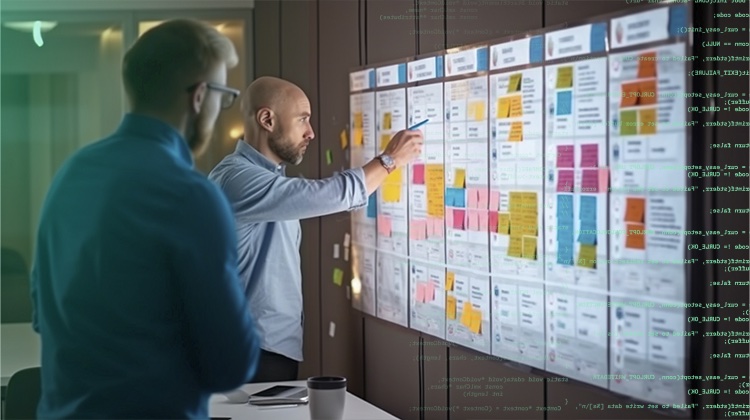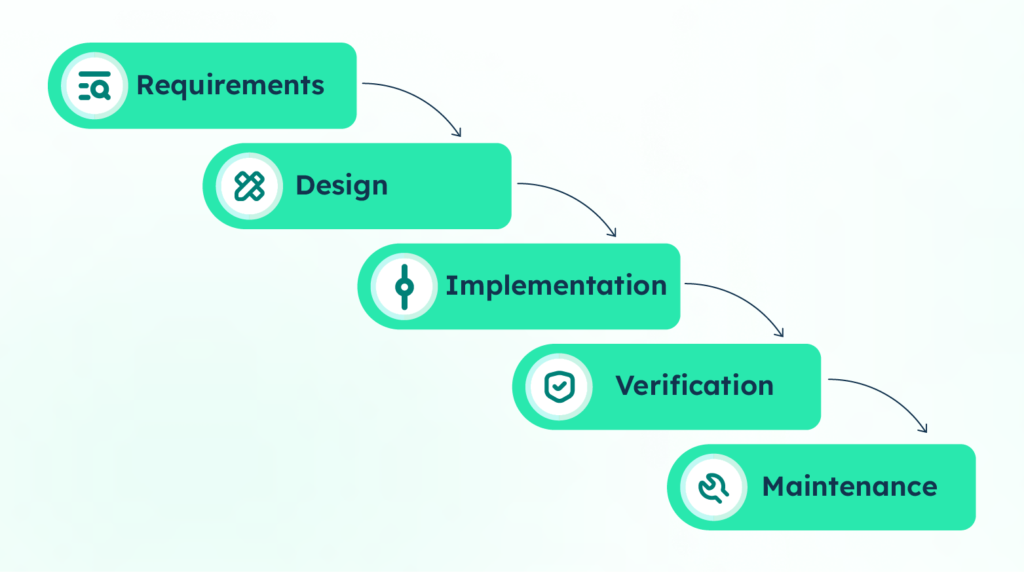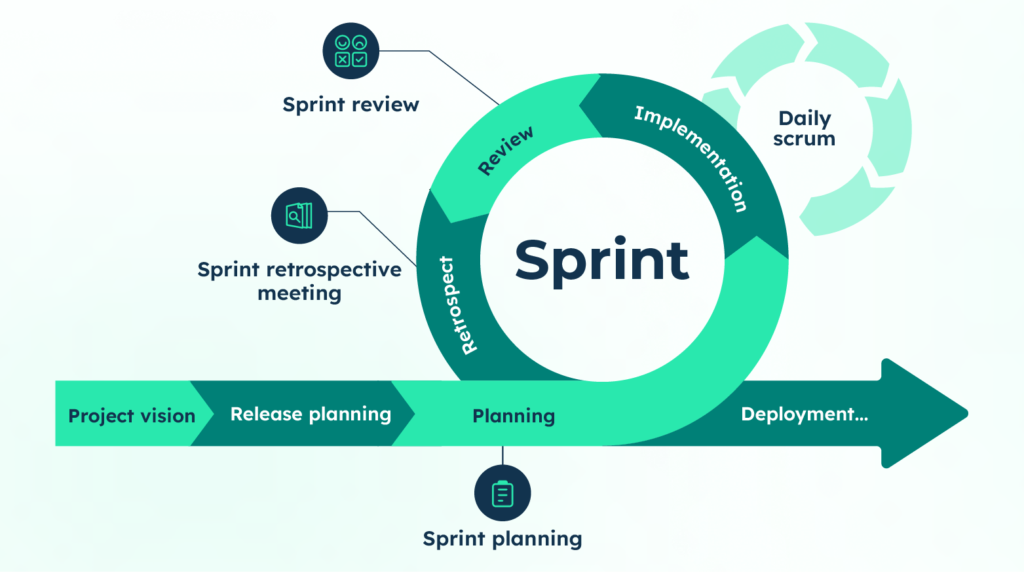Application Development Methodologies: Agile, Waterfall, and Hybrid Approaches

One of the big early decisions in any software application development project is choosing the right methodology. Do you choose between the Agile and Waterfall methodologies, or use an Agile Waterfall hybrid?
The choice is critical, but it’s not usually too difficult. The Agile, Waterfall, or hybrid project management methodology is often defined by the type of product under development.
This article gives you an overview of each. Once you know the differences between the them, the choice of methodology for your project should be obvious.
Waterfall
Waterfall project management is sometimes called traditional or predictive project management. It’s referred to as “traditional” because it was the way projects were managed before Agile came along.
It’s called “predictive” because it revolves around extensive upfront planning and following that plan throughout the project life cycle. Every phase (requirements, design, development, testing, and so on) is meticulously detailed before moving forward. This includes defining deliverables, timelines, resources, and risks.
And it’s called Waterfall because everything flows downward:

What does a Waterfall process look like?
In Waterfall, you create a project schedule in something like Microsoft Project, define all dependencies, build them into the schedule, and look at your critical path. You’re developing that plan that you’ll stick to all the way through the project. It requires extensive, careful upfront planning.
For that reason, Waterfall isn’t always the best choice for software development. It’s a rigid approach, so adapting to changing requirements is difficult and costly. Project stakeholders don’t get the chance to review work until later stages, which can make rework costly. And delays in one phase can ripple through the entire project, impacting timelines and budget.
Nevertheless, some situations suit a Waterfall methodology. If you have a clear understanding of what you want to build and the requirements are unlikely to change significantly, Waterfall’s upfront planning can be efficient. This is especially true for projects with well-defined regulations or compliance needs.
If you have strict deadlines and budgets, Waterfall’s structured approach can help you track progress and stay on course. Make your estimates carefully because, again, changes can be disruptive in Waterfall.
Smaller teams with well-defined roles may find Waterfall’s clear phases and deliverables easier to manage. However, larger or more complex projects with diverse stakeholders might benefit from a more collaborative, Agile approach.
If you’re using well-understood technology and have established development processes, Waterfall’s rigidity can minimize risks and ensure consistency. New or experimental technologies might require more flexibility than Waterfall offers.
Waterfall Pros and Cons
Pros:
- Clear structure and defined milestones: Predictable timelines and budgets, ideal for stakeholders who crave certainty.
- Thorough documentation: Every step is documented, aiding future maintenance and updates.
- Reduced risk: Well-defined requirements minimize surprises and potential scope creep.
Cons:
- Inflexible: Adapting to changing needs can be challenging, potentially leading to missed deadlines and frustrated users.
- Slow feedback loop: Feedback comes late in the process, making course correction costly.
- Large upfront investment: Requires extensive planning and documentation before development starts.
Agile
Agile teams work closely with the customer throughout the entire project, gathering feedback on the current iteration and incorporating it into the next.
Whereas Waterfall originated in physical manufacturing, Agile was developed specifically for use with software development. Some Agile ideas and approaches (such as Scrum and Kanban) were borrowed from physical manufacturing, but Agile overall was the product of software developers.
These developers recognized that many software development projects needed a methodology with more flexibility than Waterfall allowed. They established the methodology’s core principles in the Agile Manifesto, which simply says:
We are uncovering better ways of developing software by doing it and helping others do it. Through this work we have come to value:
Individuals and interactions over processes and tools
Working software over comprehensive documentation
Customer collaboration over contract negotiation
Responding to change over following a plan
That is, while there is value in the items on the right, we value the items on the left more.
Agile projects are completed in short, time-boxed increments called sprints. The customer sees and can provide feedback on the work at the end of each sprint.

What does an Agile process look like?
At the beginning of an Agile project, the product owner sits down with the team to create and prioritize the product backlog. The product backlog consists of all known requirements. In this initial meeting, you prioritize the work that needs to be done to complete the entire project. What are the must-haves? What are the nice-to-haves? And what work is beyond the project’s scope or dependent upon the completion of the project—the won’t-haves?
Once the product backlog is prioritized and refined, the first sprint begins. Sprints are generally two weeks long, although they can differ depending on the needs of the project. Within the project, they should stay the same duration from sprint to sprint.
At the beginning of each sprint, the project team picks tasks from the product backlog and puts them into the sprint backlog. The team agrees on how much work they can accomplish during the sprint and picks tasks accordingly. Then the team begins working, with the goal of completing all tasks in the sprint backlog by the end of the sprint (i.e., two weeks).
The work completed in each sprint is called the project or product increment. In Agile projects, the project increment refers to the potentially shippable product functionality delivered at the end of each sprint. It’s the tangible output of the team’s efforts during the sprint, representing a working and tested piece of the overall project vision.
The project increment is what you demo to the customer at the end of the sprint. This happens in a meeting called the sprint review. Sprint reviews are a chance for the customer to provide feedback. If they give a thumbs up, the next sprint begins with the next highest-priority tasks pulled from the product backlog.
But what if the customer doesn’t approve the work? Sometimes, they may have new ideas or the work isn’t what they expected. When the customer doesn’t approve the increment, you often end up with additional requirements in the product backlog. Before the next sprint begins, the team will need to reprioritize the backlog.
Work continues sprint by sprint until all high-priority requirements in the product backlog are completed and the customer approves the final product.
For a deeper dive into Agile, read our white paper, Agile Project Management: A Complete Guide.
Agile Pros and Cons
Pros:
- Flexibility and adaptability: Responds quickly to changing needs and user feedback.
- Faster time to market: Deliver features incrementally, reducing wait time for users.
- Increased collaboration: Fosters close communication between developers and stakeholders.
Cons:
- Unpredictable timelines: Scope and deadlines can shift based on feedback, making long-term planning challenging.
- Requires discipline and communication: Agile thrives on clear communication and strong team collaboration.
- Documentation can be lighter: May lack in-depth documentation compared to Waterfall.
Hybrid
A hybrid project management methodology is usually a mix of Waterfall and Agile, but it can also be a mix of elements from other methodologies.
You sometimes see an Agile Waterfall hybrid in companies that started off with Waterfall, but found they needed more flexibility and transitioned to Agile. They may keep the bits of Waterfall that work for them, but overall, they’re using an Agile methodology.
Hybrid agile development is a way of managing projects that blends elements of traditional Agile frameworks (like Scrum or Kanban) with aspects of more structured methodologies like Waterfall. The goal is to leverage the strengths of both approaches to create a flexible and adaptable process that can meet the specific needs of a project.
Sometimes, a hybrid project management methodology fits a particular project better than either Agile and Waterfall methodologies alone. If you’re working on a product for a highly regulated environment, for example, you might need the traceability and auditability provided by Waterfall and the iterative development of Agile.
The reality is that no one practices a pure Agile or Waterfall methodology. Every team borrows something from another methodology.
Hybrid Pros and Cons
Pros:
- Balances predictability and agility: Provides structure for core functionalities while allowing flexibility for evolving features.
- Reduces risk for critical components: Applies Waterfall for well-defined elements, minimizing uncertainty.
- Leverages Agile benefits: Enables faster iterations and quicker feedback for non-critical features.
Cons:
- Complexity of implementation: Requires careful planning and integration of different methodologies.
- Finding the right balance: Striking the optimal balance between structure and flexibility can be challenging.
- Potential for confusion: Team members need a clear understanding of both Agile and Waterfall methodologies.
Choosing Your Path
When deciding between a Waterfall, Agile, or hybrid project management methodology, consider your project’s scope, budget, timeline, tolerance for risk, and the level of change anticipated.
Remember, the ideal methodology is the one that best aligns with your unique project needs and team dynamics.
Learn More About Agile: Agile, Scrum, and the Traits of a Servant Leader (Webinar)

